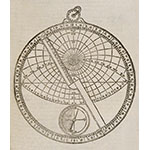Plane representation of the celestial sphere obtained with a stereographic projection (in which the projection point is located on the circumference of the celestial sphere) or orthographic projection (in which the projection point is located at infinity). The polar stereographic projection, in which the projection point is the south pole and the projection plane passes through the equator, was developed by Ptolemy in the second century C.E. for the construction of the astrolabe. In the ninth century, the Muslim astronomer Al-Zarqali (Azarchel) devised an equinoctial stereographic projection (in which the projection point is one of the equinoxes) for the construction of the "universal" astrolabe, which depicted both hemispheres. The orthographic projection was elaborated by the Spanish mathematician Juan de Rojas Sarmiento, who published it in his treatise on the astrolabe of 1550. The planisphere is the central concept in astrolabe-making.
(Polar) azimuth projection of the northern hemisphere or zenith projection of a single region. The geographic planisphere has a circular shape and is structured by a grid of radial lines representing the meridians, and a grid of concentric circles representing the parallels. At its center pivots an index that serves to measure distances between places. The planisphere was generated by rotating on a globe a strip of parchment bearing the same graduation as the index. The strip pivoted either on the North Pole or on the location of the town chosen as the center of the regional map. Distances were then recorded, by means of the index, on the planisphere disk.
Plane representation of the zodiac belt obtained by projecting the zodiacal circles on a plane parallel to the equator and tangent to the North Pole, with the South Pole as the projection center (polar stereographic projection). The belt was depicted by six concentric circles, each corresponding to a pair of zodiac signs, and by twelve transversal arcs representing the unequal-hour lines. Built for a specific latitude, the instrument served to track the Sun's apparent annual motion.








